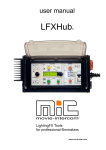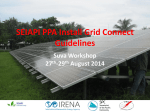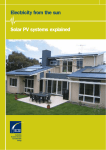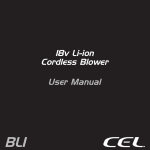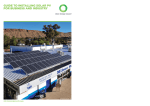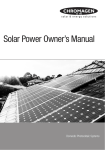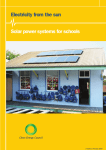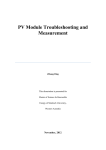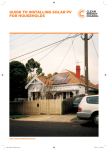Download Is there something you want to know about solar but don`t
Transcript
Turn on the sun™! Is there something you want to know about solar but don't know who to ask? Read on for the answers to all your questions. The solar power industry, which had its genesis in Australia some thirty years ago, primarily as a source of power for telecommunications sites, can now be seen in many aspects of our everyday lives. From the tiny solar panels in our watches and calculators to the large scale solar arrays beginning to appear throughout Australia. Solar power is now a significant mainstream industry. This industry creates employment, export opportunities and most importantly, a cleaner environment. With more than 60 members, Power Partners is the strongest dealer group of its kind in the renewable energy industry, combining best of breed product with years of applications experience that can't be matched. Power Partners offer solar sales and service to retail and commercial customer throughout Australia. They offer BP Solar products renowned as a world leader in renewable energy products. Power Partners strength lies in its people. Situated throughout Australia, The Power Partners dealer network has teams of technical sales people, engineers and product specialists able to assist our customers in product selection, system design and troubleshooting. Added to this are our helpful and knowledgeable customer service staff who make your order processing a simple and efficient operation. Call 1300 SOLAR 1 or visit turnonthesun.com.au This brochure has been printed on Envirocare 100% recycled paper. Contents History of Solar Power 2 What are photovoltaics? 4 How does it work? 4 What can photovoltaics do? 5 What does PV cost? 5 Is PV difficult to use? 5 What is the environmental impact? 5 Aside from PV modules, what else do I need in my PV system? 8 Why are solar cells so inefficient? 8 Will tracking improve the performance of my system? How about using reflectors to concentrate more light on the modules? 9 Is PV cost effective for residential applications? 9 How long will my PV system last? Do PV modules lose power over time? 10 What laws/ regulations cover PV? Do I need special permits? Will my insurance cover my system? 6 How are modules rated/ certified? 6 When will PV be economical for widespread use? What should I look for when purchasing a PV module? 10 7 FAQ’s about grid connect 12 Who uses PV? 7 FAQ’s about Stand-alone Power Systems 22 Does PV work in the cold? 7 Does it work in cloudy weather? How about indoors? 7 What about breakage? Don't most modules contain glass? 10 turnonthesun.com.au 2 1839 1904 1923 1954 Edmund Becquerel, a French physicist observed the photovoltaic effect. Einstein published his paper on the photoelectric effect Albert Einstein received the Nobel Prize for his theories explaining the photoelectric effect. Bell Telephone Laboratories produced a silicon PV cell with a 4% efficiency and later achieved 11% efficiency. The electric power industry is facing several challenges: • Fossil fuel supply constraints. Limited supply and escalating consumption of coal, oil, and natural gas continue to drive up wholesale electricity prices, resulting in higher electricity costs for consumers. • Infrastructure constraints. In many parts of the world, electricity demand exceeds the capacity of existing electricity generation, transmission and distribution infrastructure. • Desire for energy security. As political and economic instability in key oil and natural gas producing regions has increased, governments are increasingly focused on developing reliable and secure energy sources. • Environmental concerns. Long-term use of fossil fuels is associated with a range of environmental issues including global warming, air pollution and water pollution, the increased prevalence of which is driving increased environmental awareness. Due to the constraints on other sources of renewable energy, solar power has emerged as one of the fastest growing renewable energy sources. Solar power has several benefits when compared to other renewable energy technologies. This brochure has been printed on Envirocare 100% recycled paper. 3 1958 1973 1983 2008 Vanguard I, the first PV-powered satellite was launched. The space program has played an important role in the development of PV's ever since. The 73 oil embargo the US Department of Energy funded the Federal Photovoltaic Utilisation Program, resulting in the installation of over 3,100 PV systems. Worldwide PV production exceeded 21.3 MW, and sales exceeded $250 million. World wide demand for solar reaches 7.6GW as grid connected systems are installed in major solar markets. (Source: Photon Magazine July 2008) Benefits of solar electricity: • No fuel price volatility. Unlike fossil and nuclear fuels, solar energy has no fuel price volatility. Although there is variability in the amount of sunlight over the day and year, a properly sized and configured system can be designed for high reliability while providing a long term, fixed price electricity supply. • High reliability. With no moving parts solar power is one of the most reliable forms of electricity generation. • Environmentally benign. Solar cells generate electricity without air or water emissions, noise, vibration, habitat impact or waste generation. • Easily located with the end-user. Unlike other renewable resources such as hydroelectric and wind power, solar power can be utilised anywhere there is sunlight and directly where the power will be used. As a result, solar power limits the expense of and energy losses associated with transmission and distribution from largescale electric plants to the end users. • Peak energy generation corresponds with peak energy consumption. Maximum sunlight hours generally correspond with peak electricity demand when prices are highest. • Applicable for a wide range of power requirements. Solar power products can be sized to meet the specific needs of the end-user ranging from very small consumer applications to larger commercial applications. turnonthesun.com.au 4 Everything you need to know to “turn on the sun™” What are photovoltaics? Photovoltaic (PV) cells are solid-state semiconductor devices that convert light directly into electricity. They are usually made of silicon with traces of other elements and are first cousins to transistors, LED's and other electronic devices. through the external circuit they give up their energy as useful work (turning motors, lighting lamps, etc.) and return to the solar cell. The PV process is completely solid state and self-contained. There are no moving parts and no materials are consumed or emitted. How does it work? A PV device (generally called a solar cell) consists of layers of semiconductor materials with different electronic properties. In a typical BP Solar crystalline cell the bulk of the material is silicon doped with a small quantity of boron to give it a positive or p-type character. A thin layer on the front of the cell is doped with phosphorous to give it a negative or n-type character. The interface between these two layers contains an electric field and is called a junction. Light consists of particles called photons. When light hits the solar cell, some of the photons are absorbed in the region of the junction, freeing electrons in the silicon crystal. If the photons have enough energy the electrons will be able to overcome the electric field at the junction and are free to move through the silicon and into an external circuit. As they flow This brochure has been printed on Envirocare 100% recycled paper. 5 What can photovoltaics do? Virtually any electric power need can be met by an appropriately designed PV power system. This includes power for lighting, pumping, refrigeration, radio transmission, etc. The only limitation is the cost of the equipment and occasionally the size of the PV array, although this is rarely a factor. not imperative). PV systems with backup capability contain storage batteries that may require some watering and maintenance similar to that required by the battery in a car. What does PV cost? Although this depends greatly on the application, some general guidelines can be given. Systems containing 100 watts or more of PV will generally cost between A$10 and A$15 per watt of PV. The PV modules will be roughly 50% of the total system cost. Each watt of PV array will generally produce between 2 and 6 Wh of energy per day depending on the season and location. Some very dark conditions will produce less energy and some very bright conditions will produce more energy than this range. Using typical borrowing costs and equipment life, the life cycle cost of PV generated energy generally ranges from A$0.30 to A$1.00/KWh. This cost generally limits the current application of PV to areas, which are not served by an existing utility grid, although lowpower applications may be cost effective only a few feet from the power line. Is PV difficult to use? In a word, no. Although making PV cells and modules requires advanced technology, they're very simple to use. PV modules are generally low voltage DC devices (an array of PV modules can be wired for higher voltages) and typically require no maintenance other than occasional cleaning (and even that is What is the environmental impact? PV is probably the most benign method of power generation know. They are silent, produce no emissions and use no fuel other than sunlight. The embodied energy it takes to produce a BP Solar PV module is typically paid back within 3-4 years (based on normal operating conditions). BP Solar PV modules have an expected life of more than 25 years giving you 20 years+ of zero impact to the environment. BP Solar also makes extensive use of recycled materials and even uses waste from other industries as raw materials. While some hazardous materials are used in solar cell manufacturing, these substances are not released into the environment. Silicon, the second most common element on earth and non-toxic as used in PV cell manufacturing, is the primary component used. turnonthesun.com.au 6 What laws/ regulations cover PV? Do I need special permits? Will my insurance cover my system? While this will vary from jurisdiction to jurisdiction, PV systems are generally subject to the same electrical, building, and fire safety codes that govern the installation of electrical wiring and equipment in residential, commercial and industrial buildings. In Australia the electrical wiring standards are the accepted standard in most areas, and their guidelines should be followed in designing and installing PV systems. Properly installed PV systems are covered by most insurance policies in the same way as any other electrical equipment installed on the insured property, but the individual policy should be consulted to determine the limits of coverage. It is important to select components with appropriate safety approvals. How are modules rated/ certified? PV modules are rated at a well-defined set of conditions known as Standard Test Conditions (STC). These conditions include a PV cell temperature of 25°C, a light intensity of 1kW/m², and a particular spectral distribution of the light (air mass 1.5 or AM 1.5, which is the spectrum of sunlight that has been filtered by passing through 1.5 thicknesses of the earth's atmosphere). These conditions correspond to noon on a clear sunny day with the sun about 60° above the horizon, the PV module directly facing the sun, and an air temperature of 25°C. In production, PV modules are tested on a device known as a flash simulator. This test equipment contains a flash bulb and filter designed to mimic sunlight as closely as possible. It is accurate to about ±1%. Because the flash takes place in only 50 milliseconds, the cells do not heat up appreciably. This allows the electrical characteristics of the module to be measured at one temperature (the ambient temperature of the module/ factory), which is usually close to 25°C allowing for only minor adjustments to be made to correct the 25°C standard temperature. Most manufacturers give only nominal power ratings and a tolerance (usually±3%) for a given type of module. BP Solar also gives, in addition to its STC rating, a rating at operating conditions of 80% sun and a cell temperature of 47°C which represents conditions more common in actual operation. PV modules are certified for a number of characteristics including safety, durability, and output by a number of agencies around the world. The most significant rating agencies are U.L.(Underwriters Laboratory), F.M. (Factory Mutual), and the International Electrotechnical Commission. This brochure has been printed on Envirocare 100% recycled paper. 7 When will PV be economical for widespread use? Over 2 billion people in the developing world have no access to electricity. For these people PV is probably the most economical power source today, so in the broadest sense the answer is now. However, if the question is, 'when will PV compete with traditional power sources in countries with extensive electrical infrastructure, like Australia and the United States', the answer is that grid-connected use of PV is expanding each year. Incorporating solar electric arrays as integral parts of new building construction, or when retrofitting older buildings, has become possible in the last decade. In fact, grid connected use of solar power is growing at 30% + each year for both residential and commercial buildings. Some of this growth is also based on concerns with global warming and carbon dioxide emissions. Therefore, providing clean, renewable electrical power in urban areas can allow participation in energy conservation and pollution mitigation programs. Who uses PV? Individuals, businesses, governments, and non-profit organisations use PV. Anyone requiring electricity with or without connection to the existing grid is a potential PV user. efficiently at cooler temperatures. In temperate climates, PV's will generate less energy in the winter than in the summer, but this is due to the shorter days, lower sun angles and greater cloud cover, not the cooler temperatures. Does it work in cloudy weather? How about indoors? PV's do generate electricity in cloudy weather although their output is diminished. In general, the output varies linearly down to about 10% of the normal full sun intensity. Since flat plate PV's respond to a 180° window, they do not need direct sun and can even generate 50-70% of their rated output under a bright but overcast condition. A dark overcast day might correspond to only 5-10% of full sun intensity so output could be diminished proportionately. Indoor light levels, even in a bright office are dramatically lower than outdoor light levels, typically by a factor of several hundred or more. PV's designed for outdoor use will generally not produce useful power at these light levels, since they are optimised for much higher intensities. On the other hand, PV's designed for lower light levels like the cells found on calculators are optimised for those conditions and perform poorly in full sunlight. Does PV work in the cold? Yes, very well in fact. Contrary to most people’s intuition, crystalline PV's actually generate more power at lower temperatures, other factors being equal. This is because PV's are really electronic devices and generate electricity from light, not heat. Like most electronic devices, PV's operate more turnonthesun.com.au 8 Aside from PV modules, what else do I need in my PV system? Although a PV system can be as simple as a module and a load (such as a direct driven motor fan), many PV systems are designed to supply power whenever it is needed and so must include batteries to store the energy generated by the PV array. Systems with batteries also need electronic devices to control their charging or limit the discharging of the batteries. Since PV's and batteries are and elevate the PV modules and wiring to connect the PV modules and other components together. Why are solar cells so inefficient? This is a matter of comparison. Modern single junction mass produced solar cells are about 13-17% efficient. This is a little more than half of the theoretical maximum efficiency for such devices. Multi-junction cells could theoretically achieve efficiencies up to 50% and laboratory cells have achieved over 30% efficiency. The challenge is to increase the efficiency while reducing the cost. Since the "fuel" is free, efficiency is not the major factor limiting PV today. Usually more than enough area is available to generate the energy required. Cost is usually the limiting factor. In comparing PV's with other methods of energy generation, it is important to start from the same point. Since all fossil fuels originally got their energy from the sun, if one were to measure electrical generation from fossil fuels relative to the original solar energy source the efficiency would be a fraction of a percent! In this comparison, PV's win hands down. inherently DC devices, larger systems usually include DC/AC inverters to supply AC power in local voltages and frequencies. This enables the use of standard appliances in the system. Otherwise special DC appliances (usually from the RV or marine industry) must be used. On the electrical side, protective devices such as diodes, fuses, circuit breakers, safety switches and grounds are required to meet electric code safety standards. In general PV systems also require mounting hardware to support This brochure has been printed on Envirocare 100% recycled paper. 9 Will tracking improve the performance of my system? How about using reflectors to concentrate more light on the modules? the elevated module temperatures and light intensities can lead to premature failure of the module and for this reason, the use of artificial reflectors is not recommended and will in fact void the module's warranty. Is PV cost effective for residential applications? The effectiveness of tracking depends a lot on the climate and the application. Areas with a lot of haze or clouds won't get much benefit from trackers because the light is scattered. Also, applications where the load is the same in every month will also derive little benefit because tracking doesn't improve the performance of the system very much under worst case (usually winter) conditions. For years PV was generally not considered directly competitive with electricity from local utilities companies. However, as the cost of PV has continued to decline and electricity costs have increased, many residential home owners have been installing PV to control and reduce their electricity costs . With interest in energy efficiency and sustainable energy use increasing, it is more cost effective to install PV than ever before. Government rebates, renewable energy certificates (once your system is installed and generating clean electricity) and feed in tariffs available in most states, the return on your investment has greatly improved in the last few years. When you add these financial benefits to the environmental benefits, Grid connection of PV is proving very popular right across Australia. Under ideal conditions, trackers improve PV output per day up to 40% but they add to system complexity and expense and are not generally as robust as fixed mounting systems. Their use is generally limited to applications where the increased output matches increased demand (such as livestock watering,) in drier areas (e.g., the Australian outback). Reflectors can increase the output of PV arrays somewhat although their effect is not linear because the increased light intensity causes the module to operate at higher temperatures, which reduces its efficiency. More importantly, Note: The above graph is an indication only of current solar power costs and possible electricity price increases over time. turnonthesun.com.au 10 How long will my PV system last? Do PV modules lose power over time? What about breakage? Don't most modules contain glass? In general, the PV modules are the longestlived component of a PV system. Top quality modules, such as those in BP Solar's range, are designed to last at least 30 years and carry a 25-year limited warranty. They are designed to withstand all of the rigors of the environment including arctic cold, desert heat, tropical humidity, winds in excess of 200kph (125 mph), and 25mm (1 inch) hail at terminal velocity. Batteries will last up to 10 years (high quality industrial types). Smaller sealed units will typically last 5 to 7 years. Automotive batteries are poorly matched to the characteristics of PV systems and should not be used. Some types of PV modules (using thin film silicon) have a predictable fall off in output in the first few months of operation, which slows down and stops after some time. The modules output from then on is relatively stable. Polycrystalline modules such as BP Solar's range do not experience this kind of degradation and in fact are warranted to produce 80% of their original minimum power rating for 25 years. The most reliable, longest-lived PV modules use a glass superstrate. BP Solar's range uses low-iron tempered glass laminated with layers of plastics. This construction is very durable but given a strong enough impact, it will break. If the glass is shattered or punctured the module will eventually fail due to water getting into the solar cells and causing corrosion. It may take years for the module to completely fail (produce no power). On the other hand, if the module is damaged in such a way that the two electrical connections between any given pair of cells are both severed there will be no path for the current and the module will have no output. In summary, given enough force anything will break. The most effective protection against vandalism, theft and other catastrophes is property/casualty insurance. What should I look for when purchasing a PV module? An informed buyer will look at a number of items when buying a PV module. First, ask the seller what external agencies have tested, qualified, or otherwise approved the module. In Australia, the International Electrotechnical This brochure has been printed on Envirocare 100% recycled paper. 11 Commission’s Standards IEC61215 (crystalline modules) and IEC61646 (thin film modules) are used, plus the new module safety standard IEC61730. If modules do not comply to the relevant standard you may not receive government rebates. Next check out the module. Pick it up. Does it have a solid feel? Or does the frame easily twist. Look at the junction box. Is it solidly attached? Can it accommodate standard electrical fittings? Can it take heavy gauge wire? Can connections between modules be made in the box? Will it accommodate diodes and regulators if needed? Are the module bus bars open and well isolated or are they folded behind the cells where they can cause electrical shorts or delamination? What is the manufacturer's tolerance on power (how far below nominal can the power be and the module still be considered within specifications)? Ask the seller if it is not readily apparent. Does the module have enough voltage to charge batteries under all conditions (at least 16.5 volts at maximum power)? Examine the warranty. Is it vague or does it guarantee a specific level of performance? Finally, investigate the manufacturer. How long have they been manufacturing photovoltaics? Are they an organisation likely to still be in business in ten years? What is their reputation? Have their products proven reliable in many years of operation? Do they have a trained sales force and authorised distributor team to back up their products in the field? Power Partners invite you to put us to the test. We are confident that you will find the Power Partners team and BP Solar PV products to be the best in the industry and we hope that the information in this booklet will help you to make PV part of your life. turnonthesun.com.au 12 FAQs about grid connected solar General What is the difference between a solar electric system and a solar hot water system? PV modules generate DC electricity that is converted to AC mains quality electricity by an inverter (DC to AC converter). Solar hot water or solar thermal systems heat the water in pipes behind the glass-faced collectors and store this in a tank that is sometimes on the roof, or the storage tank can be mounted under cover and out of sight. system produces more electricity than you use, the excess electricity is sent to your power line and into the mains grid and is sold to the utility, which in effect runs your electricity meter backwards. The utility provides power at night and during the day when your electrical demand exceeds what your solar system produces. During a power outage, your solar system automatically shuts down unless the system includes battery backup at extra cost. How does a residential or grid connected solar system work? The solar cells in the modules convert the sun’s energy into a DC electrical current. This DC current flows into an inverter that changes the DC electricity to AC electricity in order to run household appliances. The AC electricity flows into your electrical switchboard to supply power to your home and if your This brochure has been printed on Envirocare 100% recycled paper. 13 What components are in a grid connect solar system? Solar modules Solar module mounting rails to Australian Standards Tin or tile roof fixing brackets to Australian Standards Grid connect inverter In-house display unit (optional) Safety signs Isolating switches Cabling Metering Manuals for owners and installers I’ve just received my electricity bill and it’s getting very high, so I’m thinking of installing a Solar Energizer kit because I want to reduce my power bills. Is this a good idea? It’s always a good idea to try and reduce your carbon footprint (a measure of the amount of carbon dioxide or CO2 emitted through the combustion of fossil fuels) by installing a Solar Energizer kit, but the amount you reduce your electricity bill depends on the size of your bill and the size of the Solar Energizer kit you may install. The average domestic consumer uses around 15-20kWh per day of electricity. What is the best way to buy a grid connect system? Power Partners supply BP Solar’s, Solar Energizer kits that come in popular sizes from a nominal 1000 watts upward. These kits include all the items required for your installer to prepare your system quickly, and not have to shop around to multiple suppliers for various components. Will a system produce enough energy to cover all my electricity needs? The amount of power produced by a system varies depending on the size of the system, your geographic location and climate. You certainly can buy a system large enough to cover all of your electrical needs. However, a solar electric system does not need to provide all of the electricity you require to be of value and reduce your power bills or carbon footprint. * Calculations based on meteorological data from Sydney Australia at a typical roof angle of 27 degrees, facing due north under average annual solar conditions. Different meteorological conditions, tilts and orientations will produce different output results. To replace this consumption with a solar electric system, say in Sydney, would require around a 3-4kW Solar Energizer kit at a retail cost of around $40-50,000 installed. However, in a competitive market this price could be much lower, plus there are government and manufacturer’s rebates available. (see page 20) turnonthesun.com.au 14 The best way to reduce the cost and the size of the solar electric system would also be to become more energy efficient by identifying all the appliances which consume the most electricity and try to replace them with more energy efficient products. For example, consider replacing all incandescent light bulbs with compact fluorescent lights. the time of the initial system purchase as he will then recommend an inverter that can be upgraded to a higher wattage unit which can then have extra solar modules added at a later date. Solar Energizer kits are designed to be upgraded as your budget allows or as electricity prices increases. The main reasons most people install a solar electric system are to reduce their carbon footprint, help reduce the need to build more large fossil-fuelled power stations, and to help reduce greenhouse gas emissions – all of which helps the planet and leaves it a better place for our children. If you are considering this because you think it will make money then it is probably not the best reason, although feed in-tariffs will make the economics more attractive. What size system can or should I install? The answer to this will depend on how much suitable roof area you have, and how much money you want to spend. Once you’ve worked out you have suitable roof space then it’s just a matter of economics. There are various system capacities available depending on how many watts of PV modules you want to put on the roof and then it’s just a matter of calculating how much of your electricity bill you wish to offset by generating your own solar electricity. Your local Power Partner will be able to advise you on this. If I want to buy a small system and add extra modules at a later time to upgrade my system power what do I do? This is certainly possible, and its much easier to discuss this with your Power Partner at Note: The graph above indicates the wattage in the standard Solar Energizer kits. It also indicates the additional number of panels that can be added to the standard Solar Energizer kit in the form of array strings. How can I see how much electricity my system is generating? The Solar Energizer kit has a optional TouchGreen™ portable LCD display system that receives data via a wireless link from the inverter. Most other systems display performance only on the inverter which is usually mounted near the switchboard and is not always convenient to view. TouchGreen™ is a portable unit that can be free-standing (e.g. on your coffee table) or can be wall-mounted, and displays information including daily and total generation, along with greenhouse gases avoided. Once you’ve made that investment you do want to be able to see what is happening to your solar This brochure has been printed on Envirocare 100% recycled paper. 15 generating system – plus show off what is happening to your friends. Components and warranties Why should I use BP Solar modules? Will my system work at night and on cloudy days? Your system will not work at night because solar modules need sunlight to produce energy. Solar modules will still produce power on a cloudy day although they will probably only produce about 20-50% as much as under full sun, depending on the cloud cover. What happens when there is a blackout? Will I still have electricity? For safety reasons the grid connect inverter will automatically disconnect your household from the grid within fractions of a second of a disruption to the grid, such as a blackout. The inverter will not provide power for the household or send any power to the grid until the mains power is returned to a safe and stable state. Otherwise there is a risk that electricity utility workers repairing power outages could be exposed to live electricity from your grid connect system. For this reason you must also have appropriate safety signs (supplied with all Solar Energizer kits) displayed which advise electrical workers on your property who may be carrying out repairs and maintenance of the existence and location of the solar generating equipment. Some installers do offer a battery back-up system to operate during blackouts but this usually requires an additional standalone inverter, batteries and a charge regulator operating on a dedicated power or lighting circuit. BP Solar have more than 30 years experience manufacturing solar modules for Australian conditions. Supporting the largest sales and marketing team of any module manufacturer operating in Australia, ensures a high level of commitment to customer service and quality. A growing number of certified installers right across Australia who are qualified and trained to install / maintain and service your PV system throughout it's service life. Products are compliant with all relevant Australian Standards BP Solar’s EnviroCashback rebate is the only manufacturers rebate offered by any of the solar module manufacturers represented in Australia What’s the difference between monocrystalline and poly or multi-crystalline modules? These days the difference is mainly price, with monocrystalline modules being slightly dearer when you compare the dollars per watt, which is the way price comparisons are done. Just divide the price by the watts of the module to do the comparison between similar wattage modules. The electrical characteristics and performance of BP Solar monocrystalline and polycrystalline modules are very similar. In the past there was a valid view that monocrystalline modules performed slightly better under high temperatures and low light conditions but these differences are now not that noticeable with advances in solar cell technology and manufacture. turnonthesun.com.au 16 Availability is another issue; multicrystalline modules are currently more readily available then monocrystalline modules. Are the modules affected by hailstones how tough are they? The glass on the front of BP Solar modules is 4mm toughened glass. All solar modules that are internationally certified are subject to an impact test that simulates the effects of a 50mm hailstone hitting the glass at around 80km/h. What is the warranty on the solar modules and the inverter? The warranty on the large area modules used in Solar Energizer kits is a 25 years 80% power guarantee, 12 years 90% power guarantee, and 5 years materials and workmanship warranty. Warranty on the SMA brand inverters in BP Solar kits is an industry-leading 10 years. How long will my Solar Energizer system last? BP Solar modules installed in grid connect applications carry a 25-year manufacturer’s limited warranty. Most solar modules show little degradation over many years of operation and have a life expectancy in excess of the warranty period. depending on how much dirt and dust they accumulate. Does the home owner have to do anything? The system is fully automatic. Metering will indicate any faults. Mounting on the roof How do I know if my roof is suitable for a solar electric system? Factors to consider are load-bearing capacity, shading, and ideally a north facing roof space. Most roofs are suitable to accept the weights involved but if in doubt please check with a qualified builder or engineer. The most suitable section of my roof to mount the solar modules does not face north For optimum performance a north-facing roof is ideal, but power can still be generated in different directions away from north. The diagram below shows the percentage of power theoretically generated by solar arrays not facing north or not mounted at the optimum roof pitch. What maintenance does the system require? We recommend that your installer performs a system check once a year, just to make sure everything is operating correctly. The modules usually don't require any more maintenance than cleaning them two or three times a year, This brochure has been printed on Envirocare 100% recycled paper. 17 It is important not to elevate the array off the roof surface as this can create substantial wind loading which in some cases might compromise the structural integrity of the dwelling. BP Solar’s Solar Energizer kits are certified to Australian Standards for mounting flat to the roof – with an air gap to promote optimum solar module performance. Elevating the array will require an engineers certification at cost, and may also result in an array which is not aesthetically attractive. It may be better to add more solar modules if you want to improve the output from an array which does not face north. Does it matter what the pitch of my roof is? The ideal roof pitch for optimum power generation is your site latitude, ± 10°. Pitch of the array is not all that critical. Ask your installer to provide an estimate of system performance that suits the design of your home. Why does the installer want to know what kind of roof I’ve got? Because there are different kits to attach the solar module mounting rails to tin or tile roofs. What about shading? The site must be free from shading because if any portion of the module is shaded, the entire module power output is lowered. It’s important to avoid shading from other buildings, parapets, trees, chimneys, or even TV antennas as this can affect power output. Installers will do a site survey prior to quote to see if shading will be an issue. I live in a high wind or a cyclone region – will the installation be OK? All Solar Energizer kits have roof mounting systems that are compliant with the Australian Standard for wind loading. For tin roofs there are upgrade kits available that provide extra mounting brackets for cyclone regions. I'm planning on building a new house, when is the best time to install a system on my roof? Ideally the electrical cables for the solar systems should be run when the electrician is running cables for all the power and lighting circuits in the house. This will save time, and possibly money, when the solar system is installed. The roof mounting rails of the solar modules can be fixed after the tin or tile roof goes on. How long does it take to install? Between 1/2 to 2 days depending on the size of the system and the roof access. For safety reasons, in some cases scaffolding may be required around the roof while the system is installed, which will add extra time and cost to the installation. Do I need permission from my electricity retailer to connect my solar system to the grid? Yes. The local utility has rules and procedures that must be followed to connect any generator to the grid safely and legally, and most utilities will have a connection agreement. Your installer will help you with the documentation and procedures. turnonthesun.com.au 18 Do I need a building approval? In most areas a building approval is not required, but you should check with your local council to see if they have any regulations in place. Where is the inverter mounted? Can you recommend someone to design and install a system for me? The Power Partners network have more than 60 dealers throughout Australia. See turnonthesun.com.au for a list of all members. Usually next to the main switchboard. SMA brand inverters as supplied in kits have the highest protection rating of IP65 and can be mounted outdoors, although its usual practice to mount them in a separate enclosure. Do I need batteries for storage like in remote solar systems? No, the grid acts as the storage facility. During the day if your grid connect system generates more electricity then your house uses you will feed the excess to the grid and be paid or credited for that excess. At night when the system is not generating electricity you will draw that “stored” electricity from the grid. Installation and sales Can I install the system myself? No. A CEC accredited solar installer or qualified electrical contractor must install the systems. I have a mate who's an electrician; can he install the grid connect system for me? Possibly, but you must have your system installation signed off by a CEC (Clean Energy Council) accredited installer to secure the SHCP rebate. Accredited installers have the experience and have done the training specific to installing solar electric power systems. Why do I have to get one of your Power Partners to do the job? Most of our Power Partners have many years of experience, as well as being accredited by the CEC (Clean Energy Council) to install your system. Installers must be CEC accredited to sign off on the installation so the home owner can receive the Federal Government rebate available under SHCP. Are quotations and designs offered free of charge? In most cases, yes. Are there Australian Standards for installation of solar systems? Yes, there are a number of standards applicable to the installation of solar systems and all installers should install systems that are compliant with those standards This brochure has been printed on Envirocare 100% recycled paper. 19 Appliances & loads cost of your system. www.greenhouse.gov.au has all the information about the rebate programs that are available. Can I run my air conditioner on the system? Your system will run and operate exactly the same as it does now with all the same appliances in use. All the grid connect system will do is offset your power consumption. Will the inverter cause interference to my TV? No, the output of the inverter is the same, if not better, than the quality of the grid power and should not cause any electrical interference. Do I have to change all my light bulbs to the new fluoro styles? If lighting is a large part of your power consumption we recommend a change to compact fluorescent lights (CFL) where possible. The Australian Government has moved to ban inefficient incandescent globes from 2009 so the cost of CFL should come down even lower as demand increases, plus more attractive designs will become available. What if I also want a Solar Hot Water system? Power Partners can offer the BP Solar Energizer Plus system that includes a solar electric grid kit and a Dux solar water heater. Grid Rebates On the 1st July 2009 the Solar Credits Scheme, which replaces the Solar Homes and Communities Plan will come into effect. Homes that install solar panels will be awarded with five-times the amount of Renewable Energy Certificates (RECs) for every megawatt-hour of clean energy their system produces. By multiplying the RECs for solar panels, the government will be supplying homeowners with enough RECs to recoup up to $7000 on the sale of their RECs in some states. The multiplier does reduce over the time of the program (2009 - 2013) Note: This legislation while finalised, is still being debated at the time of printing (see go to www.climatechange.gov.au or www.cleanenergycouncil.org.au for up to date information) Are there any other rebates available? Yes, BP Solar have the only manufacturers rebate available in the Australian market. BP Solar’s EnviroCashback offers a set amount per watt for all installations between 115 watts and 100kW. For example, on a 1kW grid connect system a rebate of $750 will be paid directly to he customer’s bank account after installation. Claiming EnviroCashback also means the customer signs over any REC’s (Renewable Energy Certificates) to BP Solar. See www.orer.gov.au for more information on REC’s. EnviroCashback is also available on Dux Solar Hot Water systems supplied by Power Partners. Do you have finance or green loans? What Government rebates are available to reduce the system cost? The Federal Government’s SHCP (Solar Homes and Communities Plan) offers substantial rebates that can help reduce the We recommend you talk to MECU www.mecu.com.au who have a goGreen® Home Improvement Loan which offers a very competitive loan rate for installing solar electric systems and other energy efficiency measures. turnonthesun.com.au 20 What is my ROI (Return On Investment) on a grid connect system? Because of the relatively low cost of electricity in Australia, the payback period on a PV system is not as short as in other countries with higher electricity prices. A typical PV system has the up front cost of buying and installing the system and then some minor maintenance costs during the life of the system. With 3 incentives available Government rebates Renewable energy certificates (REC"s) Feed in tariffs (available in most states) Feed-in Tariffs explained Payback period can vary. As an example if you are in Canberra and install a 1Kw grid connected PV system your payback will be 10 years. * An accurate ROI should be calculated for each PV system designed. The above figures are an indication only based on feed in tariffs current at the time of printing. A feed-in tariff is a premium rate paid for electricity produced by a renewable source such as a grid connected solar PV system or a wind turbine, usually over and above the market rate for electricity. At present, feed-in tariff regulations for renewable energy exist in over 40 countries around the world and have Residential (Rebates) Household taxable family income must be less than $100,000 Minimum system size Australian gov. support Eligibility New systems 450 watts Up to $8000 ($8/W up to 1kW) The system must be installed at your principle place of residence You have not previously received a rebate for a PV system from the Australian Government Extensions to old systems 450 watts Up to $5000 ($5/W up to 1kW) If you have not previously received a rebate for your system, you may be eligible for a rebate to extend your current system by 1kW If you have previously received a rebate for systems less than 1kW you may be eligible for an extension rebate to bring the system up to a 1kW capacity Community use buildings (competitive grants) 450 watts 50% of the system cost up to 2kW** Grants are available to community organisations that install PV systems where there is significant educational value. Note: *Conditions apply; this information is a guide only; for further information refer to the program guidelines. **This limit refers to the grant amount only - there are no restrictions on the size of system that can be installed. This brochure has been printed on Envirocare 100% recycled paper. 21 contributed to the strong growth in the installation of solar power in those countries. Gross vs. Net Feed-in tariff A net feed-in tariff, also known as export metering, pays the PV system owner only for surplus energy they produce or export to the grid over and above what you use from the electricity grid. Whereas a gross feed in tariff pays the PV system owner for all electricity generated by your Grid Connect PV System. Australia currently has no nationalised feed-in tariff program, only state run schemes. Here's an overview of the current feed-in tariffs in each state. Various State Governments & Utility Providers are now providing a "feed-in tariff". During those times when your electricity generation exceeds your usage, excess power is fed back into the grid and you are paid a premium for your excess electricity over and above the normal domestic electricity tariff. Feed-in tarriff overview state run schemes State Current status Max Size Rate Paid Program Duration Model VIC Commenced in 2009 3 kw 60c 15 years Net SA Commenced in July 2008 10 kw 44c+ * 20 years Net Commences March 2009 Under 10 kW - premium rate; Over 10kW - 80% of premium rate; Over 30 kW - to be determined 50.4c up to 10 kW ACT 20 years Gross (40.4c 10 kW to 30 kW) TAS Commenced tbc 20c tbc Net NT Incentive is available for 225 rooftop PV systems in Alice Springs. tbc 45.76 c/kWh. Capped at $5 per day, then reverts to 23.11c per kWh. tbc Net WA Little activity since election commitment tbc Expected to be up to 60c/kWh Likely 2 - 9 years Gross QLD Commenced in July 2008 10 kw 44c+ 20 years Net NSW Under review, to commence in 2009 tbc Not yet specified - may be approx. 60c/kWh tbc tbc The information above is a guide only. We recommend researching your local government web sites & preferred utility providers for detailed information about feed in tariffs available to your area. * TRUenergy offers 64c (See Retailer Top-up on page 22). turnonthesun.com.au 22 Retailer Top-up In addition some Electricity Retailers are beginning to "Top-up" the feed in tariff, offering an even more generous pay back. For instance TRUenergy in South Australia provide an additional 20 cents on top of the 44 cents feed-in, giving consumers a generous 64c return on the electricity they export to the grid. FAQs about Standalone Power Systems General Following is a brief FAQ section for Stand-alone Solar Power System (SPS). Every SPS installation is unique and custom designed to your electrical needs. For more details abut your SPS system please refer to your local Power Partner. What is a Stand-alone Power System? A Stand-alone Solar Power System (SPS) is not connected to the electricity grid. Together, the battery bank and the inverter supply electricity to your appliances. But, if you try to use more electrical energy than the battery bank holds, you will run the batteries too low and reduce their life expectancy. What is a hy-brid Stand-alone Power System? The number of solar modules and the size of the battery bank can be increased to generate and store more energy, or you may decide to included a diesel, petrol or LPG generator. In areas of high wind, a small wind turbine could also be an option. Such systems, which use a variety of generating technologies, are called hy-brid systems. A generator and battery charger is normally part of an SPS so that, when extended bad weather occurs, you have a back up supply which helps safeguard your batteries. To reduce load requirements, make sure that all your lights and appliances are the most energy efficient available. When do I use a generator? The advantages of an SPS with a generator are that electricity is available during prolonged periods of overcast/rainy weather, or when big power loads are required. It may also allow for a smaller battery bank and inverter to be used. The main disadvantages are the higher capital cost of the genset and battery charger, and the ongoing fuel and maintenance costs. How big will my SPS system be? A Power Partner will provide you with the system design and specification. They will: Perform a load analysis on the use of your household appliances Determine the configuration and number of solar modules Select an appropriate inverter Select a suitable battery bank Select a suitable genset Advise on any other appropriate technologies, e.g. solar water heater, wind turbine, etc. How do I determine my load analysis? The first step in the design process is to establish your electrical loads over an average day using a load analysis. This brochure has been printed on Envirocare 100% recycled paper. 23 The system designer uses the load analysis to: Calculate the daily energy demand Recommend where energy savings can be made Determine the peak power demand Select the system voltage Determine the configuration and number of solar PV modules Select the system voltage Determine the configuration and number of solar PV modules Select an appropriate inverter – power output and surge Calculate the battery size Determine size and type of genset Estimate genset use – maximum and minimum run times. The system design may need to be repeated before an economic and satisfactory ‘agreed load’ is established. Positioning summer shading or reflective coatings on west facing windows Reducing electricity demand for spaceheating and cooling (e.g.: by dressing for the climate, judicious setting of thermostats, use of curtains and incorporating energy efficiency features into new buildings, such as lights, insulation, summer shading etc.) Ensuring there’s adequate solar access in winter to provide passive heating How do I reduce demand for electricity? It is important that you consider cost-effective methods of reducing your electricity demand. These methods include: Using the most energy efficient appliances, especially refrigeration Replacing incandescent light globes with compact fluoros Avoiding quartz halogen down lights as most are very inefficient Switching off stand-by loads such as those consumed by DVD’s and computers when not in us Using LPG for some loads such as cooking and hot water Installing a solar water heater, preferably with gas boosting Utilising sensors, timer switches and home automation systems Where will my system be located? The system’s location requires consultation with your Power Partner. Suitable areas are required for the solar modules, inverter, battery bank and genset. For example: The PV modules may be fixed onto the roof or a ground-mounted frame ideally the inverter should not be exposed to the elements, though weather-proof models are available The battery bank must be in a separate, lockable and well-ventilated battery enclosure The inverter and battery charger should also be in a secure, weatherproof and well ventilated enclosure turnonthesun.com.au 24 The generator should be situated out of ear-shot and with adequate ventilation If system components are located a long way from the house, the cost of trenching needs to be considered What should be included in my SPS quotation? Mounting on roof In addition to the quotation, a contract for the supply and installation of the power system should be included with each quotation. How should my panels be mounted? Orientation Solar modules produce the most power when they are pointed directly at the sun. It is important to install them so they receive maximum sunlight. Ideally they should be in full sun format least 9am to 3pm. In Australia, solar modules should face north for optimum electricity production. Elevation For stand-alone power system, where winter operation is crucial, the angle should be the latitude plus 15°. Customisation If your roof’s slope is not ideal, your designer can create a suitable mounting frame to correct the orientation and elevation of your array. Failing this, your Power Partner can advise you on how much output you are sacrificing from the array. Average daily production Electricity is metered in kilowatt hours (kWh) where 1kWh = 1000 Wh. Hence if you use 1kW for 1 hour you have consumed 1kWh of energy. Some electrical retailers refer to 1kWh as 1 unit. Following the design and specification, you may request a quotation for the supply and installation of the system. The quotation should provide specifications, quantity, size, capacity and output for the major components, including: Solar PV modules Mounting frames or structure Battery Inverter Design, travel and transport costs Installation and other equipment costs Carpentry such as building a battery enclosure Generator (if required) Battery charger A system user manual The quotation should also specify a total price, together with a proposed start and completion dates. The quotation should form a basis for your contract with the Power Partner. While the initial cost is very important, it is wise to consider all the costs and benefits over the life of the system, including maintenance and fuel costs. It is important to remember that a good relationship with a reputable, experienced, quality installer may be more valuable than a few dollars saved on a quote. This will be a significant investment so you should ensure the decision you make is the best. This brochure has been printed on Envirocare 100% recycled paper. 25 The contract should include: Breakdowns – emergency call out An estimate of the average daily electricity output (in kWh) The estimated annual production The estimated production in the best and worst months The responsibilities of each party Warranties and guarantees, including installer workmanship A schedule of deposit and progress payments Expected operator run times in hours per month The system installer should be able to offer a quick response for any major system problems, for instance, equipment failure. Australian Standards And Industry Guidelines Stand-alone solar PV systems must comply with a range of Australian Standards covering the grid connection of energy systems via inverters, the installation of PV modules and The BCSE Design and Installation Guidelines. Documentation A system manual that provides operation, maintenance and safety information should be provided by your installer. Maintenance contracts The system installer can offer a maintenance contract. This will usually include regular maintenance visits, at agreed intervals, to ensure that your power system is performing optimally. SPS Rebates All prices include GST and rebates at 50% for up to $200,000 reimbursement of capital cost through the RRPGP program. Prices do not include installation which varies according to individual application. Installation quote can be obtained from your local Power Partner. # See www.greenhouse.gov.au for rebate details. Must be primary residence to be eligible. Also ensure you obtain written confirmation of statements made by your installer, performance claims, guarantees and warranties. Preventative maintenance After installation, the owner is responsible for ensuring the equipment is maintained in good working order. This will include checking the water in the batteries, cleaning modules and visually checking the wiring. Please note that the appropriate instruction by the installer, backed up by maintenance information in the system manual, should be provided. Safe work practices for any maintenance tasks must be followed. turnonthesun.com.au Further Reading: Power Partners www.turnonthesun.com.au BP Solar Australia www.bpsolar.com.au The Clean Energy Council www.cleanenergycouncil.org.au Department of the Environment, Water, Heritage and the Arts www.environment.gov.au/settlements/renewable/pv/index.html Office of the Renewable Energy Regulator (ORER) www.orer.gov.au Your local Power Partner is: Call 1300 SOLAR 1 or visit turnonthesun.com.au




























